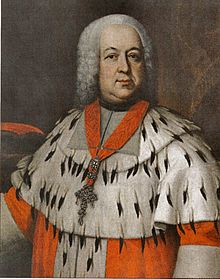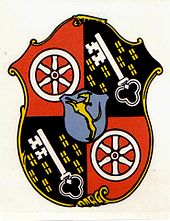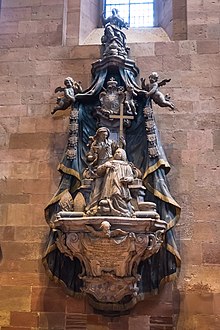Johann Friedrich Karl von Ostein
Johann Friedrich Karl von Ostein (* July 6, 1689 in Amorbach ; † June 4, 1763 in Mainz ) was an imperial count through his father from 1712 and Archbishop and Elector of Mainz and Bishop of Worms (from 1756) since 1743 .
Life
Johann Friedrich Karl came from the noble family Ostein and was a relative of the Elector Archbishop Lothar Franz von Schönborn and the Mainz Grand Court master Anton Heinrich Friedrich von Stadion . The stadium was the driving force behind the Enlightenment at the Kurmainzer Residenz.
From 1724 Johann Friedrich Karl was provost of the Frankfurt St. Bartholomäusstift and from 1725 cathedral curator in Mainz : On April 22, 1743 he was elected as a compromise candidate instead of Joseph Franz von Kesselstatt as the new Archbishop of Mainz. His cousin Friedrich von Stadion gained no small influence on political and, above all, cultural affairs under his pontificate. The archbishop could hardly play an imperial political role in the period marked by the dualism between Prussia and the Habsburg monarchy . However, he managed to defeat the raging wars such as B. to keep the Austrian War of Succession away from the archbishopric, in addition, he brokered the Füssen peace treaty of April 22, 1745 between Austria and Bavaria. Franz Stephan of Lorraine, who was then elected emperor, was crowned as Franz I on October 4, 1745. However, he remained colorless and thus strengthened the ambitions of the Prussians who began the Seven Years' War under Frederick the Great in 1756 . The Electoral State of Mainz joined the troops against the Prussians, but had to make high contributions after the occupation of Erfurt , which ruined the Electoral State's finances. Ostein therefore decided after further defeats by the allies in 1757 to be neutral, which made further influence on imperial politics almost impossible for him.
More important in the pontificate of Johann Friedrich Karls was the internal reform process in the archbishopric, which was further intensified under his successor Emmerich Joseph von Breidbach zu Bürresheim . The initiator of this process was not the Archbishop, but Friedrich von Stadion, who served as First Minister of State under Ostein. Reforms in the economy and administration followed, as well as a revitalization of the trade fair industry. In 1755 the "Kurmainzer Landrecht" was enacted as a legal reform, followed by the reform of the school system in 1758. Ostein called the "Institut Beatae Mariae Virginis" to Mainz. This religious order, founded by the Englishwoman Maria Ward , directed the school instruction of the girls from 1752 and is still active at the Maria Ward School in Mainz, unaffected by the revolution and secularization . The university was also promoted and rebuilt by the elector. However , he did not suppress the influence of the Jesuits , who were rejected by many enlighteners. This indicates that the enlightenment in church issues under Archbishop Johann Friedrich Karl could not revive. Under the Enlightenment, the archbishopric was therefore considered backward and reactionary.
The cityscape underwent major changes at the time of Ostein. The electoral palace was largely completed in 1752 . In addition, the new buildings of St. Peter and the Jesuit Church were built from 1742 to 1746 on behalf of Balthasar Neumann , as well as the Osteiner Hof and the Bassenheimer Hof on Schillerplatz.
Johann Friedrich Karl von Ostein died on June 4, 1763 and was buried in Mainz Cathedral .
literature

- Anton Philipp Brück : Johann Friedrich Karl. In: New German Biography (NDB). Volume 10, Duncker & Humblot, Berlin 1974, ISBN 3-428-00191-5 , p. 499 ( digitized version ).
- Adolf Karl Michels: The election of Count Johann Friedrich Karl von Ostein as elector and archbishop of Mainz (1743) . Darmstadt 1930; Bonn, Phil. Diss. 1930
- Elisabeth Soll: The imperial policy of Mainz Elector Johann Friedrich Karl von Ostein from the accession to government (1743) until the outbreak of the Seven Years' War . Berlin 1936; Frankfurt, Phil. Diss. 1936
Web links
- Photo of the tomb in Mainz Cathedral
Individual evidence
- ^ Ernst Heinrich Kneschke : New general German nobility lexicon . Volume 7, Friedrich Voigt's Buchhandlung, Leipzig 1867, pages 4–5. ( Digitized version )
- ^ Bernhard Schütz: Balthasar Neumann's Jesuit Church in Mainz and the plans for the Jesuit Church in Würzburg In: Mainzer Zeitschrift. Vol. 73/74, 1978/1979, pp. 49-60
| predecessor | Office | successor |
|---|---|---|
| Philipp Karl von Eltz |
Elector Archbishop of Mainz 1743–1763 |
Emmerich Joseph von Breidbach zu Bürresheim |
| Franz Georg von Schönborn |
Prince-Bishop of Worms 1756–1763 |
Johann Philipp II. Baron von Walderdorff |
| personal data | |
|---|---|
| SURNAME | Ostein, Johann Friedrich Karl von |
| BRIEF DESCRIPTION | Archbishop and Elector of Mainz and Bishop of Worms |
| DATE OF BIRTH | July 6, 1689 |
| DATE OF DEATH | June 4, 1763 |






